A self-study, self-paced course where you can learn how to paint in watercolor by watching video lessons and doing assignments
$297 USD
ENROLL NOWA self-study, self-paced course where you can learn how to paint in watercolor by watching video lessons and doing assignments
$297 USD
ENROLL NOWOne-to-one, unlimited and custom-tailored to your skills and needs Personal Tutoring by the Watercolor Academy teachers
$997 USD
ENROLL NOWBy Ilya Ibryaev
"Hello, my name is Ilya Ibryaev. I am a fine artist from Moscow, Russia. As a professional watercolor painter, I am a member of the Russian Artists' Union, as well as the International Watercolor Society. My watercolors are often exhibited in numerous fine art exhibitions both in Russia and abroad, and I have received various awards for my art. Today, I would like to show you how to paint an impressionistic artwork, which is called 'The Light Around Us'. I exhibited one of such artworks in the International Watercolor Exhibition in Spain, and this painting won the Golden Medal Award."
Here is the watercolor that I will produce by the end of this video lesson.
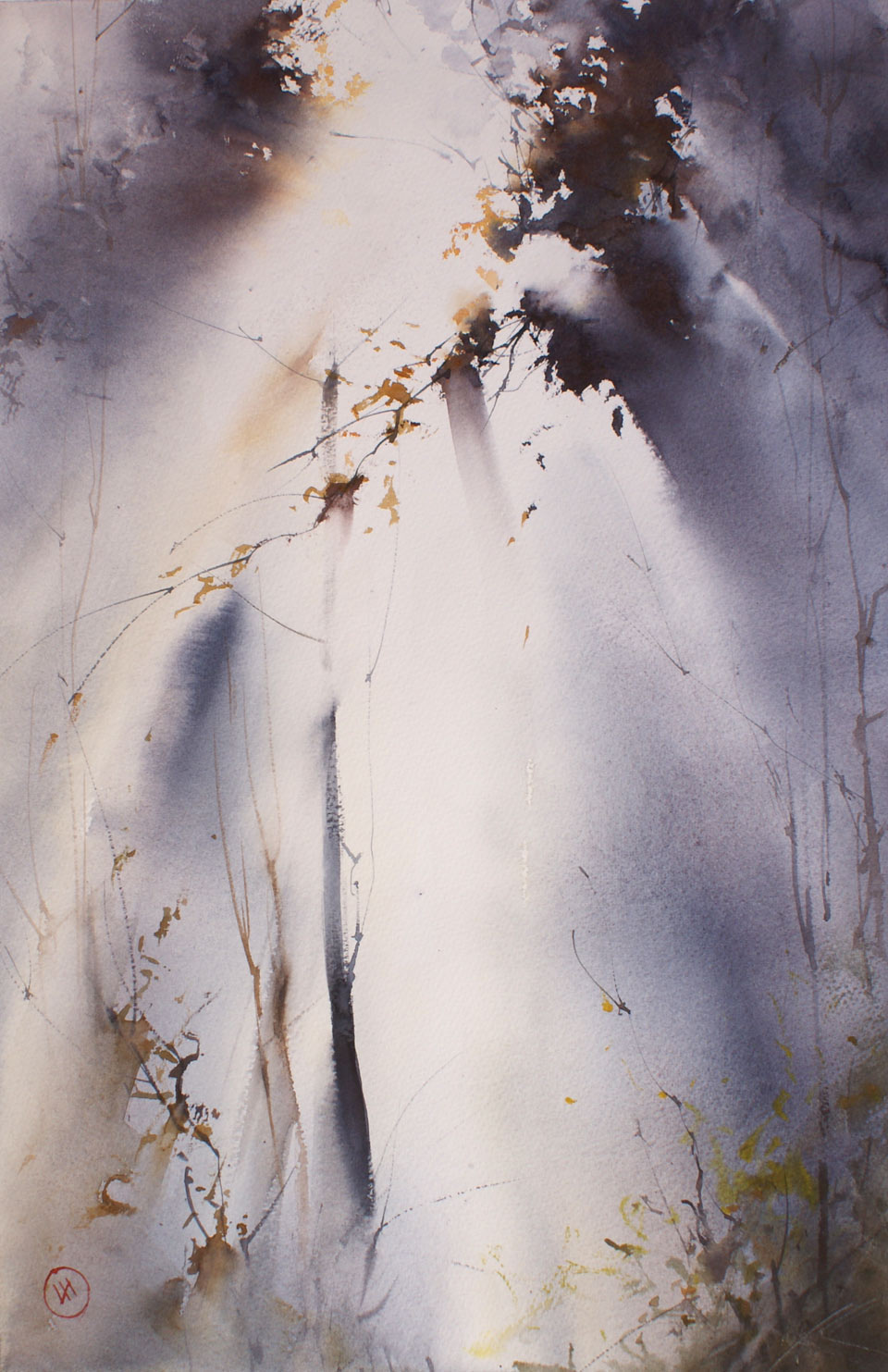
Before we begin painting, I will say a few words about the art materials I am using. Let's begin with brushes. Here is a couple of flat bristle brushes - one, and one-and-a-half-inch wide brushes. Here's another soft natural-hair flat brush, which is more suited for watercolor painting. I also have a round soft mop brush made of natural hair, that is manufactured by Rublev, as well as a smaller synthetic round brush, which is good for painting details. Also, I like the long natural hair rigger, which is capable of producing both thick and thin lines. Another brush that I like a lot is the natural Kolinsky Sable brush, and there are other flat and round smaller brushes – of both natural hair and synthetic types – which are great for making stand-alone, well-defined brushstrokes. Small flat synthetic brushes are also very useful when it comes to making brushstrokes and thin lines. Finally, there are a few more very thin long hair (both natural and synthetic) brushes that are great for making long, thin lines. My favorite watercolor paper is the Saunders Waterford, cold-pressed (or 'not') paper. It is made of 100% cotton, and has a weight of 300gsm. In terms of paint, I very much like watercolor paints made in Saint Petersburg, Russia – these paints come in tubes and pans, have a very high quality, and are reasonably priced. When working in a studio, it is better to have two jars of water: one for rinsing brushes, and another to have clean water for painting. A natural sea sponge is good to have, but it is optional. Another useful item is an atomizer, which allows you to spray artworks with clean water. Finally, paper towels or napkins can be very handy as well. I begin with spraying the paints with an atomizer, to soften them up. I also use an atomizer to wet the paper surface.
The sunrays will go from the top. To prepare their color, I mix warm pigments, such as Cadmium orange, yellow ochre light and Cadmium yellow. I dilute this mix of three colors by adding more water. Next to this mix, I also put some red, and add a little bit of green, to mute the yellow mix down. A light tint is applied on the paper, with a flat wide brush. I would also like to say a few words as to why painting such an artwork cannot be done from life; instead, it has to be done from memory. Sunshine beaming through the tree is a difficult effect to arrange; however, when you accidentally have a glimpse of this occurrence, you will get an impression of how it looks. Therefore, while in the studio later on, you can paint what you remembered about this effect.
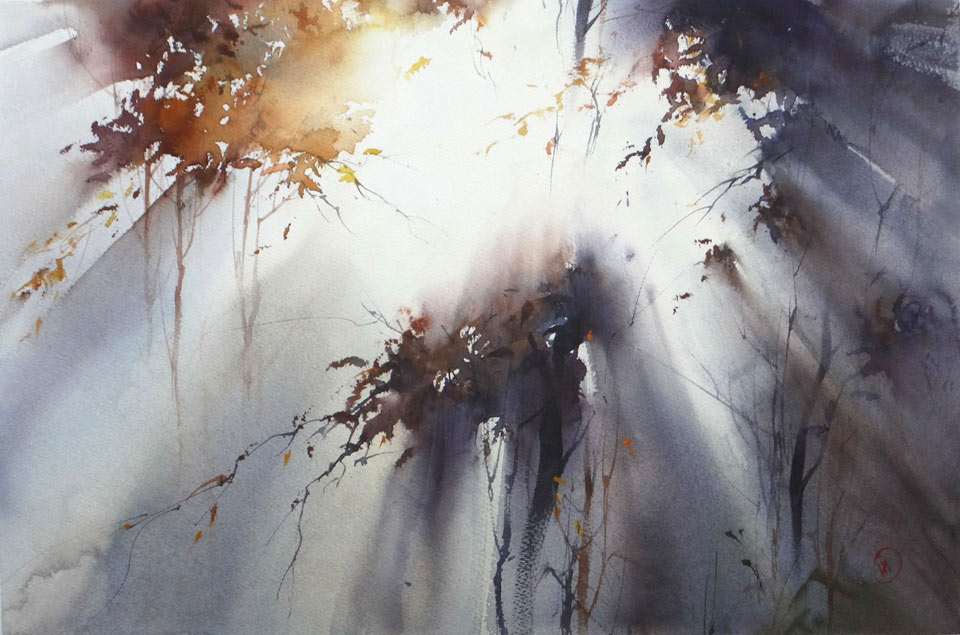
I have applied the first wash with very light vertical brushstrokes, and I now rotate the board, to allow the paint to flow across the paper surface and intermix, to produce a soft gradation. I mix Ultramarine with Cadmium orange, which are two complementary colors that produce a nice gray when mixed together. I will apply this color to produce the shadows between sunrays.
I am painting wet-into-wet, making confident brushstrokes using a flat brush. I want to make the background in 'alla prima', which means in one session, before the paper dries. When there is too much water on the paper surface, I can lift the board and hold it vertically, which allows water to run down. This painting will be almost monochrome, without highly saturated colors. The colors will be muted because we are looking against the light, and the high contrast of tonal values pay a more important role than hues and saturations. I haven't made an underdrawing for this painting. The composition of this artwork is in my head, and I will paint it in color without any sketches. Apart from using Ultramarine and Cadmium orange for shadows, I also mix Cadmium orange and Cadmium yellow to paint warm sunrays between the tree branches, which will be added later.
There are three important things that an artist must balance every time when painting in watercolor: the amount of water on the paper, how much water is loaded on the brush, and the amount of pigment also loaded on the paintbrush. To build up tonal values of this artwork, I am mixing more Cadmium orange and Ultramarine to achieve a darker shade. This mix is applied with swift and confident brushstrokes, painting dark shadows wet-into-wet. When the paper dries, this tone will become lighter. This happens because some pigments have a drying shift, and also because pigments are sinking down into the paper fibers, meaning that its white surface shows more.
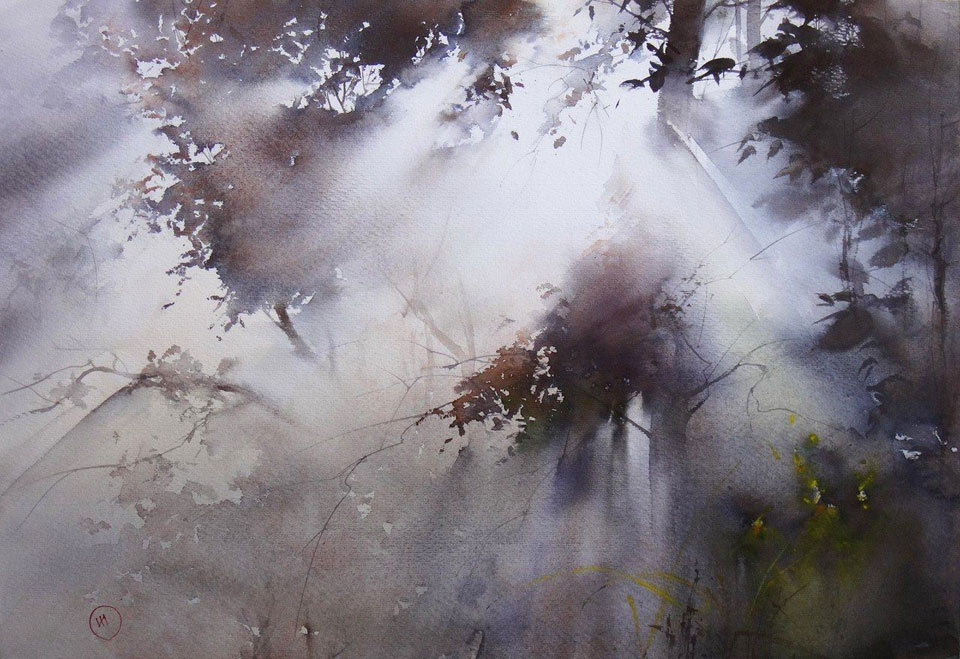
While adding more and more paint, I also lift and rotate the board, which allows gravity to do its job, and intermixes paints on the paper surface more smoothly. The key here is not to overload the paper with water; therefore, I load the brush with very little water. Also, you may notice that I'm using flat brushes, as these give wider brushstrokes, while holding less water than round brushes. When painting, you need to pay attention to how much the paper is wet. If it is soaked, it is very difficult to keep control over the paint flow. If needed, you may want to let the paper dry a bit, before continuing with painting. Also, with a damp clean brush, you may wipe off excess water, before adding more pigment if required.
You may see that I am now using a smaller flat brush, which holds even less water, but gives darker brushes. I am gradually adding more and more dark paint onto the paper, which builds up the tonal values, while working on the shadow areas of this artwork. The direction of brushstrokes is important – it follows the direction of sunrays. I dry the paper a bit; as it dries, the colors become lighter. These almost abstract gradients on paper will serve the purpose of the underpainting. I can now mix more Ultramarine and Cadmium orange, to make an almost neutral gray, and I apply this dark shade with a flat brush. To soften this brushstroke, I spray it with an atomizer. I have an approximate composition in my head, but now I have to decide on the more precise layout of the future artwork.
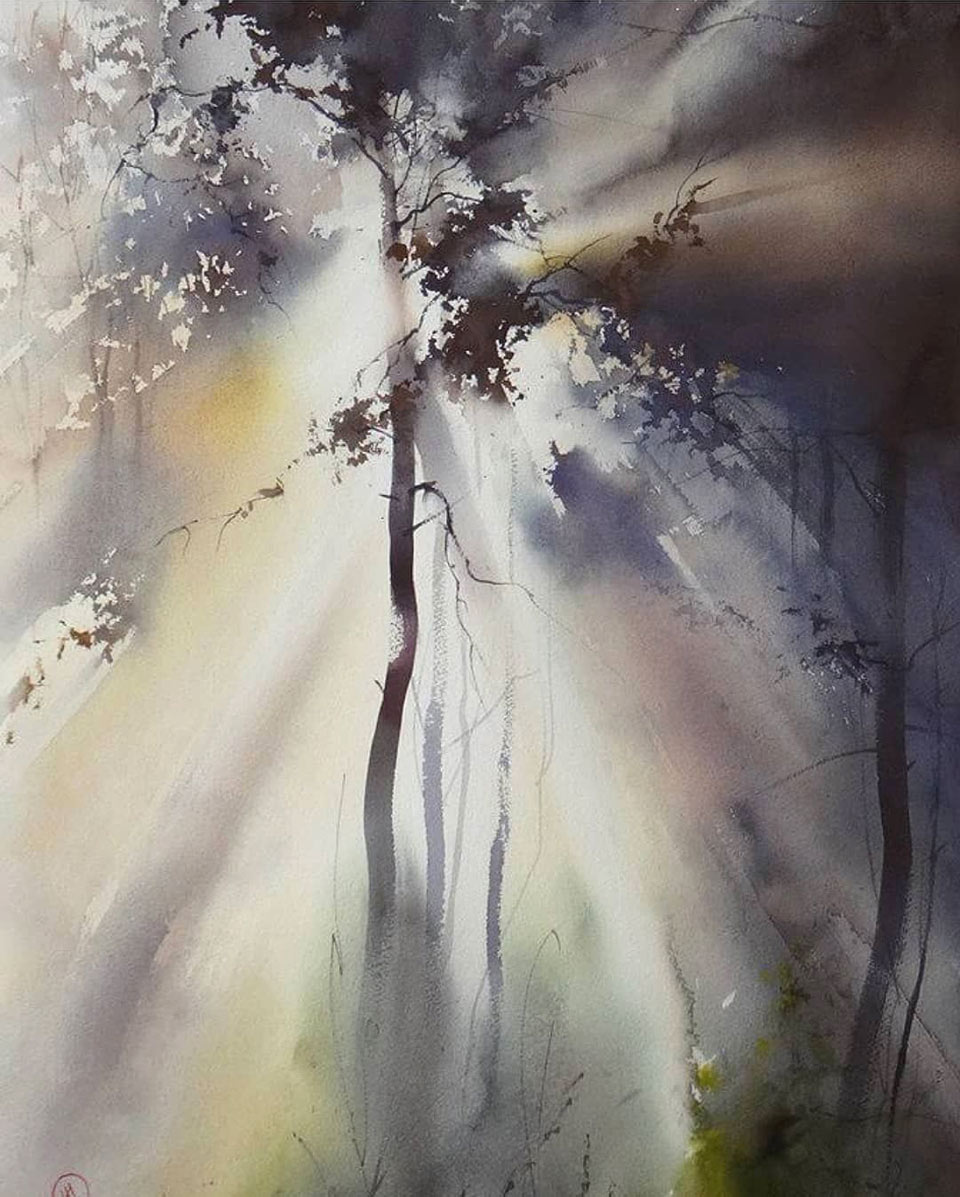
By now, the paper surface is dry. I will use a stiff bristle flat brush for painting the texture of the tree foliage. For its warm color, I mix Cadmium orange and Cadmium yellow. I load the brush with little water, but enough pigment, and I touch the paper surface lightly with the brush tip. I add a bit of Burnt Sienna to the previous mix, to make it darker. To get an even darker tone, I mix Ultramarine with Cadmium red and Cadmium orange, and I apply this mix in the same manner – with the tip of the brush. Doubling creates an interesting picturesque effect; it also saves time, as by following this method, I am able to paint multiple leaves of the tree in one touch. Because we are looking against the light, we won't see highly saturated colors, meaning that contrasts between light and dark are more important in this artwork than the contrast between different colors. From warm colors of Cadmium yellow and Cadmium orange, which are light and saturated, I have gradually made a transition to a darker shade of Cadmium orange mixed with Ultramarine, which appears as a cold gray.
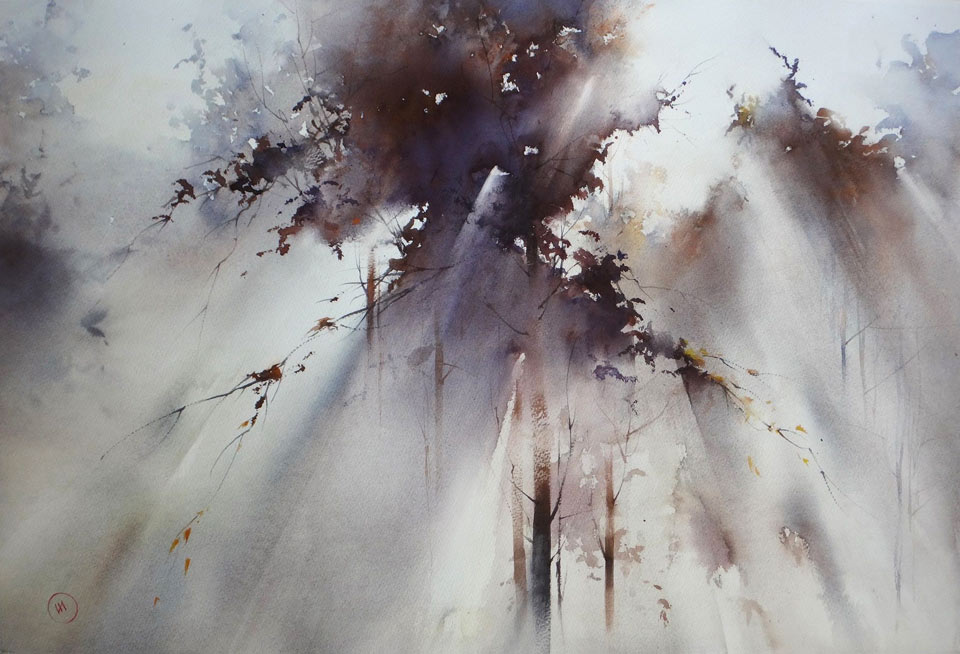
I spray this mix with an atomizer and rotate the board, to allow the paint to flow and to create an impressionistic transition between light and shadow. While the paper surface is wet, I add more paint with fast brushstrokes. I then use a clean damp brush to wipe off the paint, in order to create the sunray. I mix Cadmium orange, Cadmium yellow and a bit of Burnt Sienna to produce the warm color of the tree foliage, and apply this mix with a flat brush. I understand that you cannot see the picture I have in my mind, so I will show you the final artwork once again, for you to see what I am trying to achieve.
It is a very impressionistic artwork. It conveys the feeling of the moment when you accidentally see bright sunshine beaming through the tree foliage. I am now wiping off the pigment, with a damp paper towel, to create more texture and to preserve the white paper color. The purpose of this video lesson is not just to show how to make this particular artwork, but to demonstrate and explain the different methods and techniques of watercolor painting. Some smaller details are added with the liner brush. I dry the paper surface before continuing with more defined details.
Painting with the small brush gives great control over the graphical design of this picture. It's time to add another tree branch at the top. As previously, I do it with the flat bristle brush, applying the mix of Ultramarine with Cadmium orange. A warmer and darker shade can be achieved by adding Cadmium red into this mix. Speckling paint with a wide brush is a fast way to create an impression of the bushy leafage. You may notice that the color for the greenery does not contain green pigment whatsoever; instead, I am using the whole range of colors from warm to cold and from light to dark, including Cadmium yellow, Cadmium orange, Burnt Sienna, Cadmium red and Ultramarine pigments. A limited number of pigments helps to concentrate on tonal values rather than colors.
I wash up the soft-hair flat brush, and with swift movements, I spread the paint across the paper to create an illusion of shadows in the air. I also load dark pigment onto the brush, and deepen up the tonal values of these shadows. To soften up the hard edges, I spray these brushstrokes with clean water; I also spread out the pigment on paper with the brush. While the paper surface is wet, the paint spreads out, so to preserve the white color of the paper, you may need to wipe off the pigment with a clean, damp brush. Drying the paper with a fan will stop the paint from spreading. It's time to take care of the bottom half of this artwork. I am using the same limited palette of pigments, to keep the top and bottom parts of this artwork in the same style.
The background is done – it looks almost monochrome. Now, I mix Cadmium orange, Cadmium yellow and Sap green to add more colors to this artwork. This greener leafage is in the foreground, and therefore its color is more saturated. To create an illusion of aerial perspective, higher contrasts between light and dark, and brighter and warmer colors, have to be applied to the objects which are closer to a viewer. On the other hand, the objects which are further away should have less contrast, lighter tones and be pale in color. It's time to paint the foreground objects, like the tree trunks for example. I want to create an illusion of the mist, which is lit by the sunshine. That is why the tree trunk at the bottom diffuses into the fog, and casts a shadow into the air. I use a small, round, longhair brush to paint thin branches and twigs, which are depicted very schematically. I also add some leaves with a small brush, in a warm color mixed from Cadmium orange and Ultramarine, and spread the paint with a flat brush to suggest the casted shadow. A combination of small well-defined details, with white soft gradient washes, gives this artwork an interesting appearance. Despite these well-defined details, this is still a very impressionistic artwork, and I would like to finish it before it is fully done. All that remains for me to do is to sign it.
A self-study, self-paced course where you can learn how to paint in watercolor by watching video lessons and doing assignments
One-time payment - Lifetime membership
$297 USD
One-to-one, unlimited and custom-tailored to your skills and needs Personal Tutoring by the Watercolor Academy teachers
One-time payment - Lifetime membership
$997 USD